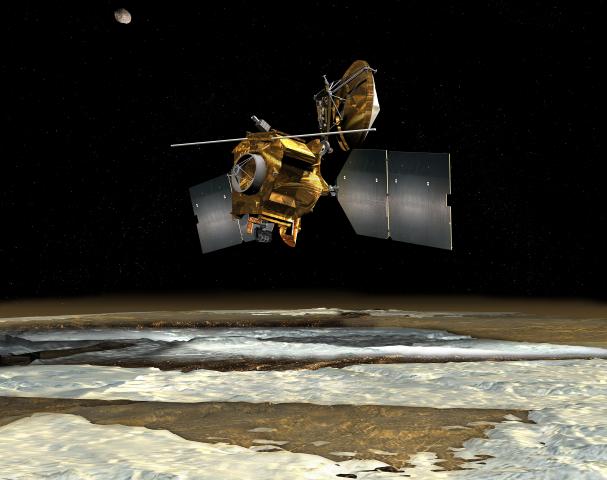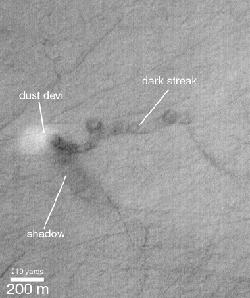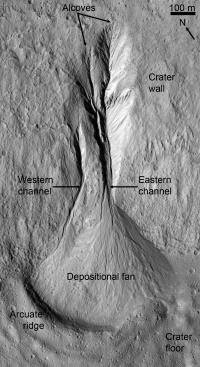Mars gullies research and discussion topics

This may well be the closest to the present that liquid water flowed on Mars.
Gullies are known to be young surface features on the Red Planet.
But Mars scientists have struggled to find gullies they can date with any certainty.
"You never end up with a pond you can put goldfish in," Schon said. "But you have transient melt water."
Those discoveries built on evidence that Mars was occasionally wet for far longer than was once thought possible.
All this evidence leads scientists to believe that some parts of the Red Planet were warm and wet not so long ago
A gully system that had running water as recently as 1.25 million years greatly increases the time that water might have been active on Mars.
It also adds to evidence of a recent ice-age on the planet.
During this ice-age, ice from the poles moved towards the equator and settled in mid-latitudes.

But by zooming in with the HiRISE camera aboard the Mars Reconnaissance Orbiter ...
Next came the task of trying to date these.
This means its axis was tilted so the winter half got very little sunlight
Around half a million years ago the planet shifted so its axis was much less tilted.
The team tested other theories of what water could have been doing in the gully system.
"It didn't last long," he says. "But it happened."
8-Dec-2008

No goldfish
Scientists have found gullies on Mars where water from melting snow and ice once flowed - as recently as 1.25 million years ago, they say. This may be the closest to the present that liquid water flowed on Mars.
Gullies are known to be young surface features on the Red Planet. But Mars scientists have struggled to find gullies they can date with certainty. Now in a paper in Geology, Brown University researchers have dated a gully system in Promethei Terra - an area of cratered highlands in the southern mid-latitudes. They also suggest what the water was doing there.
Melt water
The gully system has four channels where sediments were carried by water down the steep slopes of nearby alcoves, said Samuel Schon, a Brown graduate student and the paper's lead author. They were then deposited in alluvial fans.

"You never end up with a pond you can put goldfish in," Schon said. "But you have transient melt water. You had ice that typically sublimates. But in these instances it melted, transported and deposited sediment in the fan."
The finding comes soon after discoveries of water-bearing minerals such as opals and carbonates - reported by Brown graduate student Bethany Ehlmann in a paper in Science in December. Those discoveries built on evidence that Mars was occasionally wet for far longer than was once thought possible.
Warm and wet
All this evidence leads scientists to believe that some parts of the Red Planet were warm and wet not so long ago. A gully system that had running water as recently as 1.25 million years greatly increases the time that water might have been active on Mars. It also adds to evidence of a recent ice-age on the planet.
During this ice-age, ice from the poles moved towards the equator and settled in mid-latitudes, says James Head III, professor of geological sciences at Brown. He first estimated the length of the martian ice-age in a Nature paper in 2003.
"We think there was recent water on Mars," says Head, who is a contributing author on the paper, along with Brown postdoctoral researcher Caleb Fassett. "This is a big step in the direction to proving that."
The gully system is inside a crater in Promethei Terra. Its eastern and western channels each run less than a kilometre from their alcove sources to the fan deposit.

Want a date?
From a distance the fan seems to be one entity that is several hundred metres wide. But by zooming in with the HiRISE camera aboard the Mars Reconnaissance Orbiter, Schon was able to pick out four separate lobes in the fan.
Next came the task of trying to date these. Schon used a technique based on counting craters. Large rocks that hit a planet leave large craters. Around the rim of these craters the surface is left smooth and flat at first, because of the material thrown out.
Over time smaller rocks from space leave smaller craters on the new surface. It becomes more and more pockmarked. So scientists can estimate how long a large crater has been there by counting the small craters around its rim.
The gully fan Schon studied is 80 kilometres from a large crater. Using the crater-counting technique, this large crater was estimated to be 1.25 million years old.
When the rock that left this crater crashed into Mars a lot of debris was scattered by the impact. This left smaller craters all around. Some of these can be seen at the edge of the gully fan. The images show that mud was deposited over the top of these craters. So they must have been there already when the water flowed.
This means that water flowed in the gullies no more than 1.25 million years ago.
'Mid snow and ice
The team determined that ice and snow formed in the alcoves at a time when Mars had "high obliquity". This means its axis was tilted so the winter half got very little sunlight. Ice was gathering then in mid-latitudes . Around half a million years ago the planet shifted so its axis was much less tilted. The ice in the mid-latitudes began to melt or change directly into vapour.
The axis of Mars has been at a small tilt angle ever since This is why no exposed ice is now found beyond the poles.

The team tested other theories of what water could have been doing in the gully system. They ruled out groundwater bubbling to the surface, Schon says, because it seems unlikely to have happened many times in the planet's recent history.
Deposits like these could have been left by a dry landslide. But the shape of the channels in the deposits strongly suggests that water was involved.
By far the best explanation, say the Brown University scientists, is that snow and ice melted to create modest flows of water on the surface of Mars, and to form the fan that we now see 1.25 million years later.
Schon thinks that water likely flowed for a few hours to a few days. "It didn't last long," he says. "But it happened."
Adapted from a press release written by Richard Lewis at Brown University.
More help with words
| alluvial | carbon dioxide | compound | conference | deposit |
| element | experiment | equator | geology | hypotheses |
| impact | journal | orbit | PhD | pole |
| research | sandstone | sedimentary | sheen | tentative |
